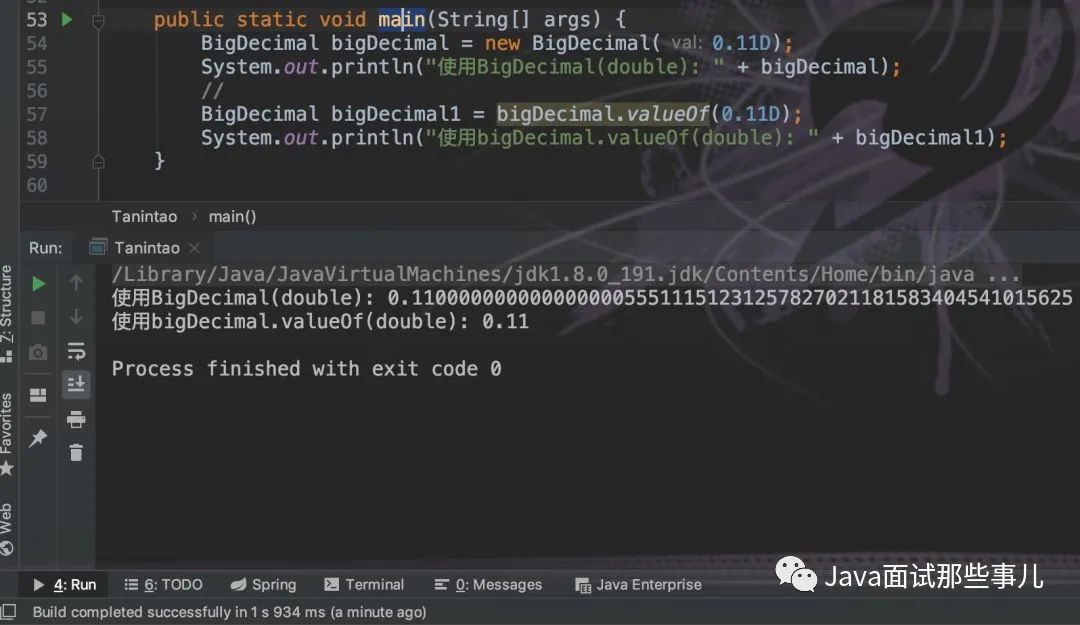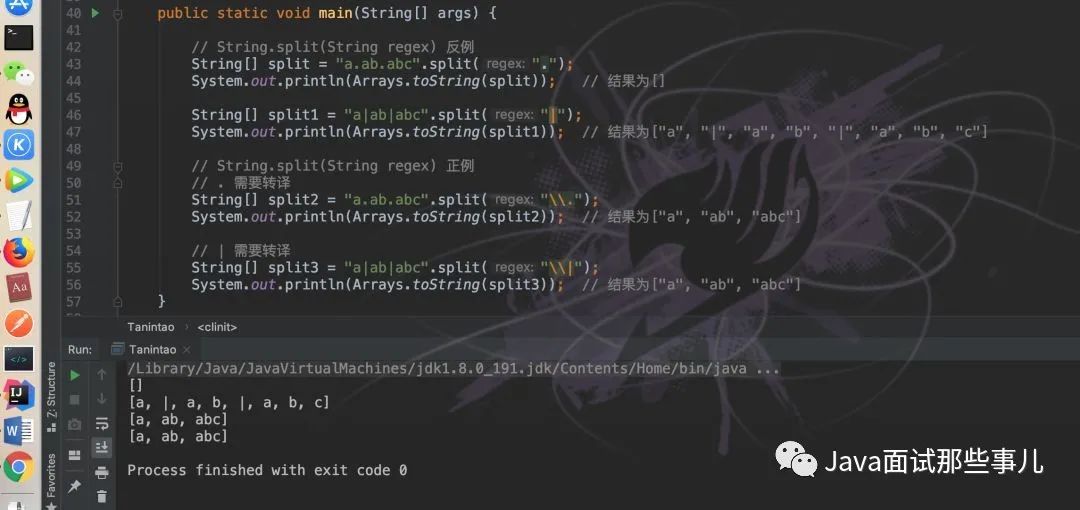16 条 yyds 的代码规范
阅读本文大概需要 8.5 分钟。
作者:涛姐涛哥
来源:cnblogs.com/taojietaoge/p/11575376.html
如何更规范化编写Java 代码
<select id="queryBookInfo" parameterType="com.tjt.platform.entity.BookInfo" resultType="java.lang.Integer">select count(*) from t_rule_BookInfo t where 1=1<if test="title !=null and title !='' ">AND title =</if><if test="author !=null and author !='' ">AND author =</if></select>
<select id="queryBookInfo" parameterType="com.tjt.platform.entity.BookInfo" resultType="java.lang.Integer">select count(*) from t_rule_BookInfo t<where><if test="title !=null and title !='' ">title =</if><if test="author !=null and author !='' ">AND author =</if></where></select>
//Map 获取value 反例:HashMap<String, String> map = new HashMap<>();for (String key : map.keySet()){String value = map.get(key);}
//Map 获取key & value 正例:HashMap<String, String> map = new HashMap<>();for (Map.Entry<String,String> entry : map.entrySet()){String key = entry.getKey();String value = entry.getValue();}
LinkedList<Object> collection = new LinkedList<>();if (collection.size() == 0){System.out.println("collection is empty.");}
LinkedList<Object> collection = new LinkedList<>();if (collection.isEmpty()){System.out.println("collection is empty.");}//检测是否为null 可以使用CollectionUtils.isEmpty()if (CollectionUtils.isEmpty(collection)){System.out.println("collection is null.");}
//初始化list,往list 中添加元素反例:int[] arr = new int[]{1,2,3,4};List<Integer> list = new ArrayList<>();for (int i : arr){list.add(i);}
//初始化list,往list 中添加元素正例:int[] arr = new int[]{1,2,3,4};//指定集合list 的容量大小List<Integer> list = new ArrayList<>(arr.length);for (int i : arr){list.add(i);}
//在循环中拼接字符串反例String str = "";for (int i = 0; i < 10; i++){不会对其进行优化str += i;}
//在循环中拼接字符串正例String str1 = "Love";String str2 = "Courage";String strConcat = str1 + str2; //Java 编译器会对该普通模式的字符串拼接进行优化StringBuilder sb = new StringBuilder();for (int i = 0; i < 10; i++){//在循环中,Java 编译器无法进行优化,所以要手动使用StringBuildersb.append(i);}
//频繁调用Collection.contains() 反例List<Object> list = new ArrayList<>();for (int i = 0; i <= Integer.MAX_VALUE; i++){//时间复杂度为O(n)if (list.contains(i))System.out.println("list contains "+ i);}
//频繁调用Collection.contains() 正例List<Object> list = new ArrayList<>();Set<Object> set = new HashSet<>();for (int i = 0; i <= Integer.MAX_VALUE; i++){//时间复杂度为O(1)if (set.contains(i)){System.out.println("list contains "+ i);}}
//赋值静态成员变量反例private static Map<String, Integer> map = new HashMap<String, Integer>(){{map.put("Leo",1);map.put("Family-loving",2);map.put("Cold on the out side passionate on the inside",3);}};private static List<String> list = new ArrayList<>(){{list.add("Sagittarius");list.add("Charming");list.add("Perfectionist");}};
//赋值静态成员变量正例private static Map<String, Integer> map = new HashMap<String, Integer>();static {map.put("Leo",1);map.put("Family-loving",2);map.put("Cold on the out side passionate on the inside",3);}private static List<String> list = new ArrayList<>();static {list.add("Sagittarius");list.add("Charming");list.add("Perfectionist");}
public class PasswordUtils {//工具类构造函数反例private static final Logger LOG = LoggerFactory.getLogger(PasswordUtils.class);public static final String DEFAULT_CRYPT_ALGO = "PBEWithMD5AndDES";public static String encryptPassword(String aPassword) throws IOException {return new PasswordUtils(aPassword).encrypt();}
public class PasswordUtils {//工具类构造函数正例private static final Logger LOG = LoggerFactory.getLogger(PasswordUtils.class);//定义私有构造函数来屏蔽这个隐式公有构造函数private PasswordUtils(){}public static final String DEFAULT_CRYPT_ALGO = "PBEWithMD5AndDES";public static String encryptPassword(String aPassword) throws IOException {return new PasswordUtils(aPassword).encrypt();}
//多余异常反例private static String fileReader(String fileName)throws IOException{try (BufferedReader reader = new BufferedReader(new FileReader(fileName))) {String line;StringBuilder builder = new StringBuilder();while ((line = reader.readLine()) != null) {builder.append(line);}return builder.toString();} catch (Exception e) {//仅仅是重复抛异常 未作任何处理throw e;}}
//多余异常正例private static String fileReader(String fileName)throws IOException{try (BufferedReader reader = new BufferedReader(new FileReader(fileName))) {String line;StringBuilder builder = new StringBuilder();while ((line = reader.readLine()) != null) {builder.append(line);}return builder.toString();//删除多余的抛异常,或增加其他处理:/*catch (Exception e) {return "fileReader exception";}*/}}
//把其它对象或类型转化为字符串反例:int num = 520;// "" + valueString strLove = "" + num;
//把其它对象或类型转化为字符串正例:int num = 520;// String.valueOf() 效率更高String strLove = String.valueOf(num);
// BigDecimal 反例BigDecimal bigDecimal = new BigDecimal(0.11D);
// BigDecimal 正例BigDecimal bigDecimal1 = bigDecimal.valueOf(0.11D);

//返回null 反例public static Result[] getResults() {return null;}public static List<Result> getResultList() {return null;}public static Map<String, Result> getResultMap() {return null;}
//返回空数组和空集正例public static Result[] getResults() {return new Result[0];}public static List<Result> getResultList() {return Collections.emptyList();}public static Map<String, Result> getResultMap() {return Collections.emptyMap();}
//调用 equals 方法反例private static boolean fileReader(String fileName)throws IOException{// 可能抛空指针异常return fileName.equals("Charming");}
//调用 equals 方法正例private static boolean fileReader(String fileName)throws IOException{// 使用常量或确定有值的对象来调用 equals 方法return "Charming".equals(fileName);//或使用:java.util.Objects.equals() 方法return Objects.equals("Charming",fileName);}
public enum SwitchStatus {// 枚举的属性字段反例DISABLED(0, "禁用"),ENABLED(1, "启用");public int value;private String description;private SwitchStatus(int value, String description) {this.value = value;this.description = description;}public String getDescription() {return description;}public void setDescription(String description) {this.description = description;}}
public enum SwitchStatus {// 枚举的属性字段正例DISABLED(0, "禁用"),ENABLED(1, "启用");// final 修饰private final int value;private final String description;private SwitchStatus(int value, String description) {this.value = value;this.description = description;}// 没有Setter 方法public int getValue() {return value;}public String getDescription() {return description;}}
// String.split(String regex) 反例String[] split = "a.ab.abc".split(".");System.out.println(Arrays.toString(split)); // 结果为[]String[] split1 = "a|ab|abc".split("|");System.out.println(Arrays.toString(split1)); // 结果为["a", "|", "a", "b", "|", "a", "b", "c"]
// String.split(String regex) 正例// . 需要转译String[] split2 = "a.ab.abc".split("\\.");System.out.println(Arrays.toString(split2)); // 结果为["a", "ab", "abc"]// | 需要转译String[] split3 = "a|ab|abc".split("\\|");System.out.println(Arrays.toString(split3)); // 结果为["a", "ab", "abc"]

推荐阅读:
内容包含Java基础、JavaWeb、MySQL性能优化、JVM、锁、百万并发、消息队列、高性能缓存、反射、Spring全家桶原理、微服务、Zookeeper、数据结构、限流熔断降级......等技术栈!
⬇戳阅读原文领取! 朕已阅 
评论

